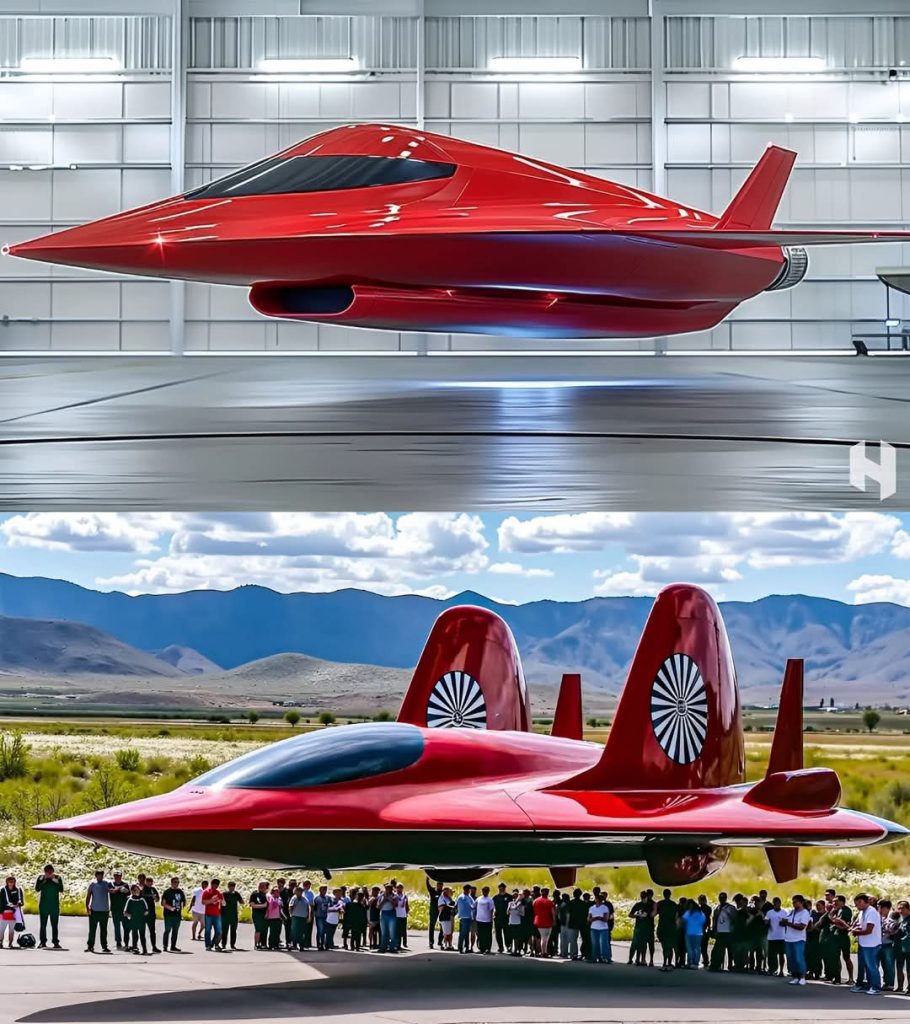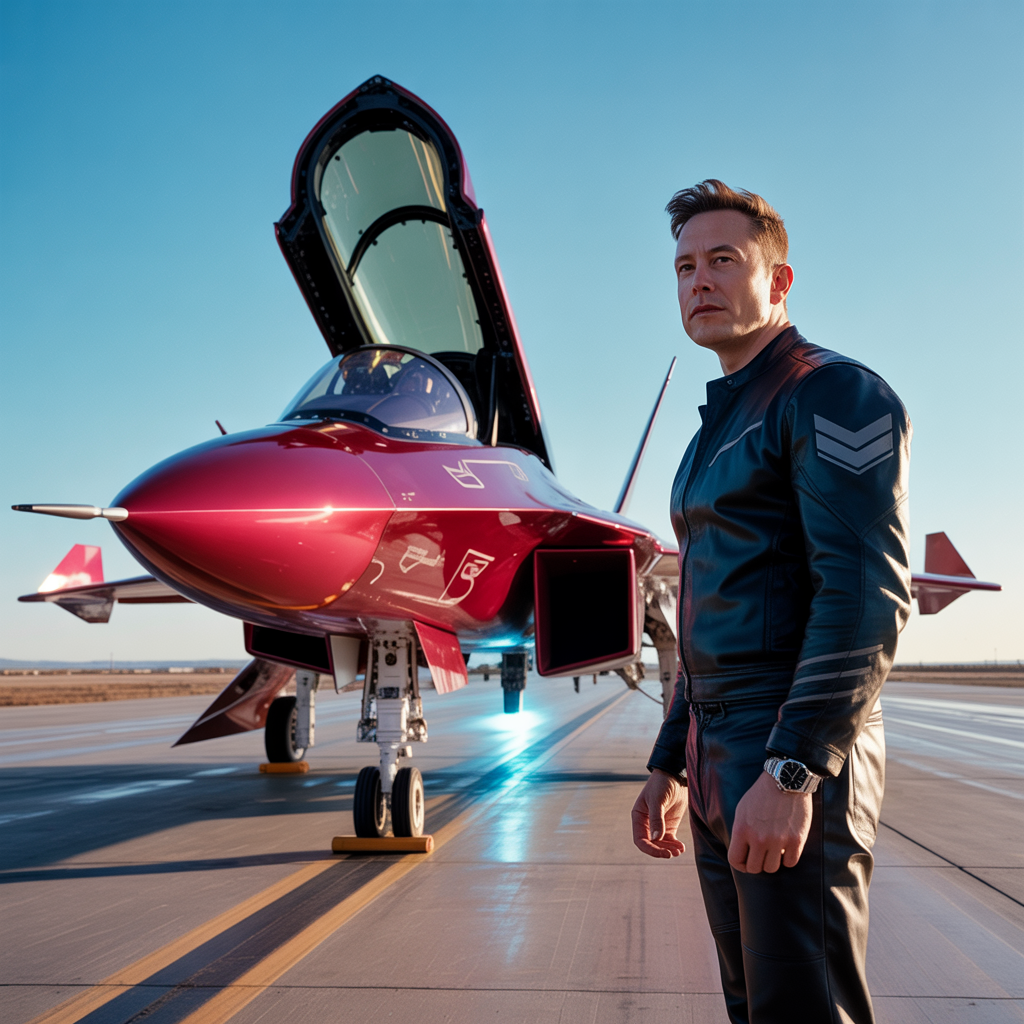A ripple of disbelief swept across the tech and aviation worlds today as Elon Musk stood beside what may be the most audacious engineering feat of our time. Inside a high-security hangar, flanked by engineers and global media, he pulled back the curtain on a sleek, gleaming red aircraft unlike anything ever seen before. At first glance, it looked like it belonged in a science fiction movie. But this wasn’t fiction. It was real. And it was about to change everything.

This $13 billion aerial machine is not just another prototype or an evolution of existing designs. According to Musk, it represents a full-scale reimagining of how flight works. With its knife-like nose, seamless body curves, and absence of visible lift mechanisms or traditional wings in its base model, the aircraft challenges even the most basic assumptions about aerodynamics and propulsion. And the world is taking notice.
During the dramatic unveiling, Musk walked the audience through the impossible-sounding features of the aircraft. With the confidence only he can command, he described an aviation breakthrough that boasts near-zero drag, vertical lift-off capabilities, and propulsion that defies conventional thrust mechanics. “This aircraft doesn’t just reduce resistance,” Musk said, gesturing toward the hovering prototype. “It manipulates the very environment around it.”
Spectators in the hangar were left stunned as the red aircraft silently levitated, its metallic skin gleaming under industrial lights. The bottom half of the event took place outdoors, where the jet was flown over a crowd of engineers and guests, casting a surreal shadow on the tarmac. The sight was cinematic, even dreamlike—two tail fins extended skyward like sails, stabilizers rotating with mathematical precision, and no visible exhaust or heat distortion. For a moment, it felt like the laws of gravity had been suspended.
Experts have been quick to point out that if the claims are true, this could mark the birth of a new era in aviation. The vehicle reportedly uses an advanced propulsion system that combines electromagnetic lift with a proprietary energy field generator, rumored to be a heavily modified fusion-capable core. This technology, still largely shrouded in secrecy, could eliminate the need for fossil fuels entirely in long-range air travel.
But it’s not just performance that sets this aircraft apart. Its shape alone breaks from tradition. It lacks the wing span of a conventional jet, instead relying on internal structural lift generators, which Musk’s team describes as “dynamic skin.” This skin reportedly adjusts itself in real-time using AI-driven micro-motors and nano-fiber tension cables. In simpler terms, the plane molds itself mid-flight to optimize speed, stability, and lift based on weather conditions, altitude, and velocity.

And speaking of speed—one of the most staggering features is its reported acceleration. The craft is said to reach hypersonic speeds within seconds, dramatically reducing travel time between continents. Imagine boarding a flight in Los Angeles and landing in Tokyo just two hours later. That’s the vision Musk painted, and he insists it’s within reach before the decade closes.
Of course, with a price tag of $13 billion, the aircraft is not being built for commercial airlines. At least not yet. Musk hinted that the first models are intended for “strategic aerospace deployment,” which may include defense contracts, emergency response missions, and interplanetary logistics for future SpaceX endeavors. However, he remained optimistic that scaled-down versions could reach the private and commercial sectors in time.
As with many of Musk’s bold announcements, skeptics have begun questioning the feasibility. Can current materials withstand the stress of such rapid acceleration? Can energy systems truly be that compact and efficient? And perhaps most importantly—how does it fly without traditional wings?
To those questions, Musk responded with a characteristic grin and a simple phrase: “Physics is only a boundary until you break it.”
If his words prove true, this aircraft could mark the beginning of a future that aviation pioneers only dreamed of. Beyond transportation, it could unlock new potential for humanitarian aid, space colonization, and planetary defense. Musk teased that the next generation of the craft would be space-capable, transitioning effortlessly from Earth’s atmosphere to orbital paths with no additional propulsion stages.
The implications are profound. An aircraft like this doesn’t just make travel faster. It changes how we think about borders, distance, and time. With almost silent operation, zero emissions, and advanced AI piloting systems, it may usher in a new age of ethical, efficient air travel and redefine how humanity moves across the planet—and eventually, the stars.
Standing beside the hovering masterpiece with the mountains rising behind him, Musk closed the unveiling with a vision both grounded and galactic. “This is not just about flight. It’s about freedom—freedom from the limits we once thought were fixed. Freedom to reach new worlds. This is what the future looks like. And today, we begin building it.”
As the crowd erupted in applause and the red aircraft quietly lifted off into the sky, one thing became certain. The age of impossible aviation might be over—and Elon Musk just handed us the key to what comes next.